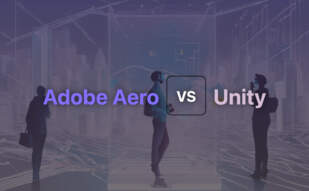When comparing Adobe Aero and Zappar, Aero shines for designers needing AR without coding, amplifying the Adobe suite experience. Zappar, however, is favoured by brands desiring a comprehensive AR/XR solution, hosting beginner to advanced coders with rich tools.

Key Differences Between Adobe Aero and Zappar
- Platform Accessibility: Adobe Aero is currently limited to iOS, while Zappar supports both iOS and Android.
- Coding Necessity: Aero enables AR creation without coding; Zappar accommodates all levels of coding expertise.
- Integration: Aero integrates with Adobe Creative Cloud; Zappar integrates with Sketchfab’s 3D model library.
- Target Audience: Aero suits artists, educators, and marketers. Zappar solutions cater to brands across multiple domains.
- AR Capabilities: Aero specializes in real-world AR experiences; Zappar offers both world and facial tracking.
- Experience: Zappar presents 12+ years of AR domain experience.
| Comparison | Adobe Aero | Zappar |
|---|---|---|
| Platform | AR Creation Tool | XR Platform & Creative Studio |
| User Experience | Simplified, intuitive – minor bugs | Flexible, caters to beginners to expert coders |
| Key Feature | No coding/3D design needed | End-to-end camera strategy |
| Platform Availability | iOS exclusive | iOS & Android |
| Viewer Mode | Interact with creation, changes publishable | AR experiences hosted via Zappar App |
| Tools Highlight | Intuitive gestures for asset placement, rotation, scale | Drag-and-drop mechanism for AR experience creation |
| Strengths | Simplified AR development, Adobe Suite compatibility | Accessible, increases engagement, brand loyalty and conversion rates. Caters to multiple domains |
What Is Adobe Aero and Who’s It For?
Adobe Aero is an intuitive tool for creating augmented reality without needing any coding or 3D design experience. It integrates with Adobe Creative Cloud applications like Adobe Photoshop and Illustrator for content input. By enriching user experience with interactive behaviors and motion paths, it makes AR experiences come alive in the real world. This tool is a boon for artists, educators, and marketers who want to experiment and create dynamic content with little to no AR development knowledge

Pros of Adobe Aero
- Intuitive user experience
- No coding or 3D designing skills required
- Compatibility with Adobe Creative Cloud applications
- Interactive experiences with behavioral content triggers
- Ability to share progress through videos or snapshots
Cons of Adobe Aero
- Currently only available for iOS devices
- Some reported bugs and limitations
- Missing advanced features present in other AR platforms
- Backup necessity with projects failing to open
What Is Zappar and Who’s It For?
Zappar, combining an XR platform and creative studio, has crafted an end-to-end camera strategy for content creation, management, and publishing. With an experience spanning 12 years, Zappar has mastered creating memorable and engaging AR experiences leading to increased brand loyalty and conversion rates. This accessible tool benefits packaging, retail, learning & development, marketing, tours, and more. Big brands are amongst their customer base, marking them as a leader in the AR space.

Pros of Zappar
- End-to-end solution for AR content creation, management and publishing
- Accessible to the visually impaired
- Advanced scripting editor for expert coders and easy experience for beginners
- Introduction of world tracking and facial tracking
- Integration with Sketchfab’s 3D model library
Cons of Zappar
- Experiences hosted via Zappar App may limit standalone use
- Requires users to incorporate AR in existing apps
Adobe Aero vs Zappar: Your Ultimate AR Toolkit
When it comes to AR experience creation, we’re faced with two giants: Adobe Aero and Zappar. But let’s get straight to the point: Which should you choose?
For Artists and Designers
If you’re an artist or designer, Adobe Aero offers unbeatable compatibility with Adobe Creative Cloud suite, allowing you to easily integrate existing workflow and realize creative visions with no coding necessary.

For the Coders
Zappar, however, owns the day for the coders out there. Thanks to its advanced scripting editor, it provides a flexible platform to concoct complex interactive programs and broad mobile support.

For Businesses and Marketers
Businesses and Marketers would do well with both, given Aero’s ability to quickly prototype and share experiences and Zappar’s demonstrated increase in engagement and brand loyalty.

In conclusion, Adobe Aero reigns supreme for designers and artists with its seamless Adobe Creative Cloud integration, while Zappar outshines for coders due to its profound scripting capabilities. Businesses, however, may find value in both depending upon their unique needs.
Logan Bellbrook
Content writer @ Aircada with a knack for nature & AR/VR/XR. Blogging the intersection of tech & terrain.





